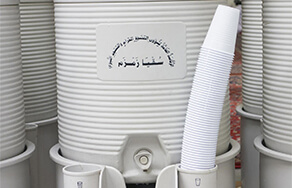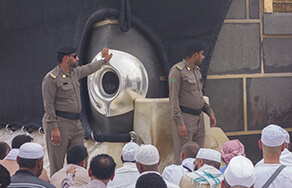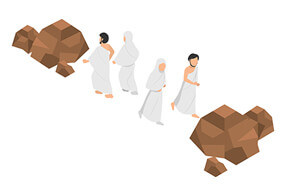Kaabah is the House of Allah situated in the Holy Mosque “Masjid-Al-Haram” in Makkah. It is the first and the most ancient place of worship ever built & dedicated to worship the one God for all of humankind.
The direction to face towards the Kaabah while praying Salah.
The black stone in the north-eastern corner of the Kaa’bah is called Hajr-e-Aswad (In Arabic language, Hajr means Stone & Aswad means Black).
Ibn-e-Abbas narrated that Allah's Messenger (pbuh) said:
“When the black stone came down from paradise, it was whiter than milk but
the sins of the sons of Adam turned it black and Hajjis should kiss it if they get a chance.”
Multazam is the southern part of the wall between the door of the Kaa’bah and the black stone. Pilgrims embrace this part of the wall and make dua to Allah. In a Hadith the Prophet (pbuh) said, “Whoever calls Allah upon Al- Multazam, He will answer their prayer”.
The north-western corner of the Kaa’ba that faces towards Yemen; which is why it is called Rukun-e-Yemeni (Yemen's Pillar). It is not appropriate to kiss this part during tawaf.
A short distance away from Kaa’bah towards North, there is an open space that has small walls around it but no ceiling, it is called Hateem. According to a tradition of the Prophet (pbuh) it is suggested that this place was left without a roof because enough wood was not available to cover the entire building of Kaabah. A pilgrim should keep this place inside the Tawaaf but it is not right to face Hateem while offering salah.
Maqam-e-Ibrahim is a small round-shaped monument in front of the door of the Kaa’bah and the Multazam. This Gold plated monument has a stone that was used by Prophet Ibrahim (AS) to stand on to complete the walls of the Kaa’bah and one can still see his foot prints on the stone.
After completing the seventh tawaf during the pilgrimage, two Raka't of nafl salah is offered near the Maqam-e-Ibrahim.
Allah Almighty says in the Holy Quran:
وَإِذْ جَعَلْنَا الْبَيْتَ مَثَابَةً لِّلنَّاسِ وَأَمْنًا وَاتَّخِذُوا مِن مَّقَامِ إِبْرَاهِيمَ مُصَلًّى وَعَهِدْنَا إِلَىٰ إِبْرَاهِيمَ وَإِسْمَاعِيلَ أَن طَهِّرَا بَيْتِيَ لِلطَّائِفِينَ وَالْعَاكِفِينَ وَالرُّكَّعِ السُّجُودِ
And when We made the House a place of return for mankind and (a place o) security and (said), "Take [from] (the) standing place (of) Ibrahim, (as) a place of prayer." And We made a covenant with Ibrahim and Ismail [that], "[You both] purify My House for those who circumambulate and those who seclude themselves for devotion and prayer and those who bow down and those who prostrate. (Al Baqarah:125)
Mutaaf is a circle of white stone around the Kaa’bah where Tawaaf is performed during the pilgrimage.
ZamZam is the name of the famous well in Masjid Al-Haram situated at a distance of thirty cubits away from the Kaabah. This well sprung up when Ismail (AS) as an infant struck the Earth with his heels in thirst while his mother Hajira (RA) looked for water as she climbed to the top of Mount Safa and prayed to Allah (SWT) for help, and then she climbed the Mount Marwah and did the same. Allah (SWT) responded to her supplication and sent Jibreel (AS) to dig out the well of ZamZam.
Two small hills in Makkah located in the north of Masjid-Al-Haram which have been flattened now. Hajira (RA) ran seven times between these two hills in search of water. Pilgrims are ordained to follow her footsteps and perform circuits of these hills seven times.


